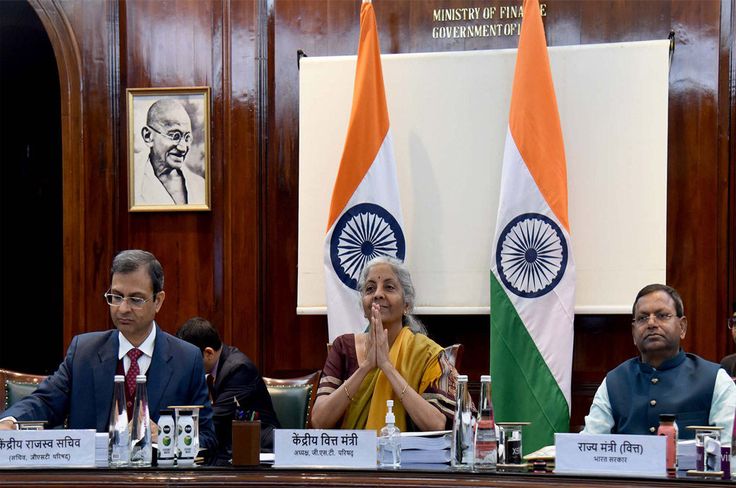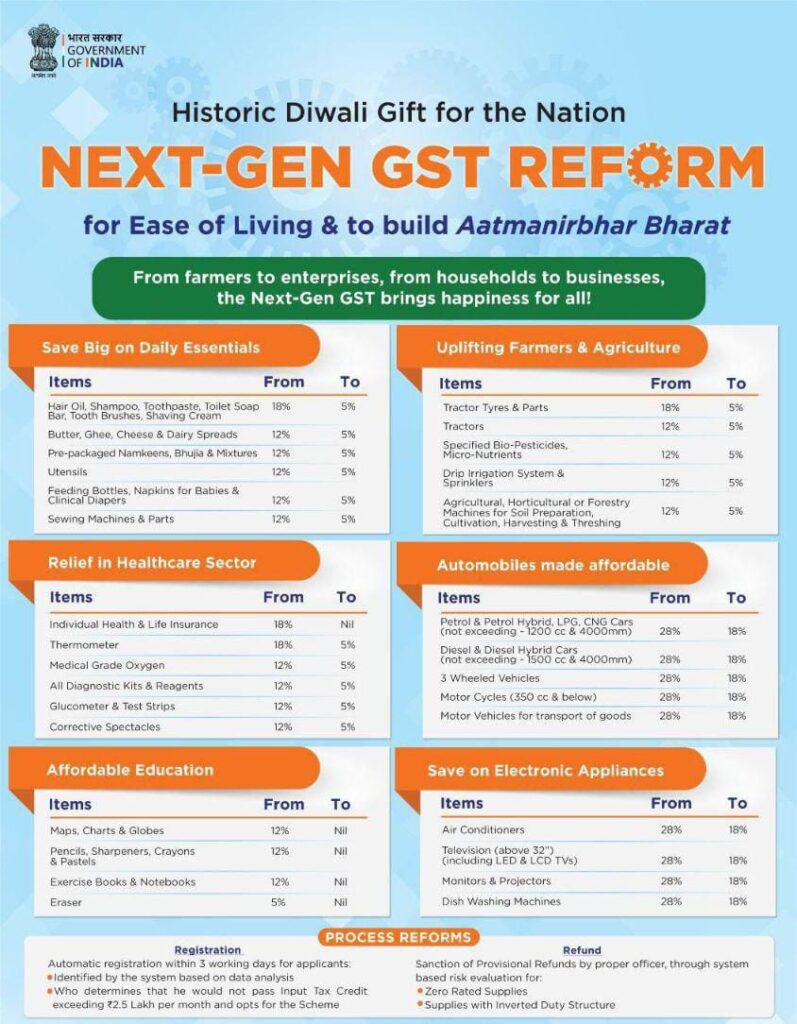New tax era begins as GST Council approves major overhaul aimed at simplification, compliance ease, and growth.
In what is being described as the most significant reform since the introduction of the Goods and Services Tax (GST) in 2017, the government on Thursday unveiled GST 2.0, introducing a simplified two-slab tax structure. The GST Council, after months of deliberation, cleared the proposal, with the new rates set to come into effect from September 22, 2025.
The decision is being hailed as a landmark move to reduce complexity, widen compliance, and provide relief to businesses as well as consumers. While some states expressed concerns over revenue implications, the overall consensus was that a simpler tax regime will drive better collections in the long run.
What Changes Under GST 2.0?
The existing GST framework, which currently has multiple slabs — 0%, 5%, 12%, 18%, and 28% — will now be collapsed into just two categories under GST 2.0.
Lower Slab: Expected to cover essential goods and services, including food items, medicines, education, and daily-use commodities.
Higher Slab: Will apply to luxury goods, premium services, and sin products such as tobacco and alcohol-related items.
While the exact percentages of the new slabs have not yet been disclosed officially, insiders suggest that the lower slab may be set around 8–10%, and the higher slab between 16–18%, with cess continuing on demerit goods.
The Council has promised to issue detailed notifications within the next two weeks, giving businesses sufficient time to adapt before the rollout.
Why GST 2.0 Was Needed
Since its launch in 2017, GST has been one of India’s most ambitious tax reforms, unifying a fragmented system of state and central levies into a single national tax. However, both firms and customers were frequently perplexed by the intricacy of many tax slabs.
Economists and trade bodies had long argued that the existence of five different rates not only complicated compliance but also led to disputes and classification issues. For instance, whether a particular food item should attract 5% or 12% became a frequent point of contention.
The Council’s decision was announced by Finance Minister Nirmala Sitharaman, who said:
“GST 2.0 is a move in the direction of more equity and simplicity. The two-slab system will reduce disputes, improve compliance, and make life easier for small traders and large corporations alike. Most importantly, it will benefit the common citizen by eliminating confusion and hidden costs.”
Key Highlights of the Announcement
Two Slabs Approved: Simplification of rates with effect from September 22, 2025.
- Exemptions to Continue: Essential items such as fresh fruits, vegetables, and healthcare services will remain zero-rated.
- Technology Upgrade: GST Network (GSTN) to undergo major updates to help businesses transition smoothly.
- Compliance Relaxations: Quarterly returns would be made simpler for small traders with annual revenue under ₹1.5 crore.
- Revenue Compensation: The Centre has assured states of a transition fund to offset any temporary loss in revenue.
Industry Reactions
The business community responded largely positively to the announcement.
Federated Indian Chambers of Commerce and Industry, or FICCI:
“A simplified GST regime with fewer slabs has been a long-standing demand of industry. GST 2.0 will significantly reduce classification disputes and compliance burden.”
CII (Confederation of Indian Industry):
“The move will encourage investment, improve ease of doing business, and help India climb further in global competitiveness rankings.”
Traders’ Associations:
Smaller businesses welcomed the compliance relief but urged clarity on the exact rate bands.
Meanwhile, consumer groups expressed cautious optimism, saying the impact on household budgets would depend on how the new slabs are defined.
Political and State-Level Response
While most states backed the reform, some raised concerns over potential revenue shortfalls. Kerala and Punjab sought assurances on compensation, while Maharashtra called for higher cess on luxury cars to balance state finances.
The Finance Minister clarified that the Centre would create a GST Transition Fund to support states during the shift.
“No state will lose out in this reform. We are committed to ensuring fiscal stability during and after the transition,” Sitharaman said.
Opposition leaders, however, accused the government of “rushing through” the reform without adequate consultation. Yet, the mood in the Council remained largely cooperative.
What It Means for Consumers
In the immediate term, GST 2.0 may provide people with both relief and uncertainty:
- Essential items like food grains, medicines, and education are expected to remain in the lower or exempted category, preventing price hikes.
- Daily-use household goods currently at 12% may shift downward to the lower slab, making them cheaper.
- Luxury and lifestyle products could see a moderate increase, depending on final slab placement.
- Services such as restaurants, telecom, and travel will also be realigned, impacting household budgets.
Experts believe that while some items may become costlier, the overall consumer impact will be neutral or slightly positive, as lower compliance costs eventually translate into lower retail prices.
Transition Challenges for Businesses
Though the move is welcomed, businesses face short-term challenges:
- Reclassification of Products: Companies must update accounting systems, pricing, and billing.
- Technology Upgrade: ERP and billing software need updates to align with the new slabs.
- Stock Management: Goods lying in warehouses will need careful rate adjustments to avoid losses.
- Awareness and Training: SMEs, especially in tier-2 and tier-3 towns, will need handholding.
The government has promised a dedicated helpdesk, training modules, and webinars to guide businesses through the change.
A Step Toward Global Best Practices
Globally, most countries operate with either a single VAT/GST rate or two slabs. India’s initial multi-slab structure was seen as a compromise to protect revenue and balance inflation.
As the economy developed and GST collections showed steadiness, recently topping ₹1.8 lakh crore per month, policymakers felt at ease simplifying the system.
Economist Dr. Rakesh Mohan noted:
“This reform was inevitable. A two-slab GST aligns India more closely with global best practices and signals maturity in fiscal policy. Over time, India may even move to a single rate.”
Expected Impact on the Economy
- Boost to Compliance: Simplified slabs reduce disputes and encourage voluntary compliance.
- Wider Base: Lower evasion is expected as businesses find the system easier.
- Higher Revenues: Though some states worry about short-term dips, experts predict sustained revenue growth in the medium term.
- Consumer Confidence: Transparent pricing builds trust and stimulates spending.
- Investment Climate: A simpler tax regime attracts domestic and foreign investors.
Road Ahead
The Finance Ministry has set a clear timeline:
- Sept 8, 2025: Final notification of slab percentages.
- September 10–20: National consumer and corporate awareness campaign.
- Sept 22: Official rollout of GST 2.0.
Beyond September, the government plans to monitor the impact closely. Adjustments may be made if unintended consequences arise, particularly for small-scale industries and states heavily reliant on GST revenue.
Voices From the Ground
To capture the public mood, our team spoke to traders, consumers, and experts across India.
Ravi Kumar, small trader in Delhi:
“Earlier, I was always confused whether to bill 12% or 18%. Now with two slabs, life will be easier. I hope the paperwork also reduces.”
Meena Sharma, homemaker in Jaipur:
“If essentials stay cheap, I’m happy. But they must ensure electricity and telecom don’t get costlier.”
Rajiv Bansal, tax consultant in Mumbai:
“Transition will be tough for some months. But eventually, this will bring uniformity and reduce litigation. We’ve been waiting for this.”
A New Chapter in India’s Tax Journey
India makes a daring move to streamline its indirect tax system with GST 2.0. While challenges remain in transition and implementation, the consensus is that the reform will boost compliance, reduce disputes, and make taxation more transparent.
As the September 22 rollout date approaches, all eyes will be on how businesses adapt, how states manage revenue, and how consumers respond to price changes. If successful, GST 2.0 could mark the beginning of a truly “One Nation, One Tax, One Market” era.
Related News: Read More





